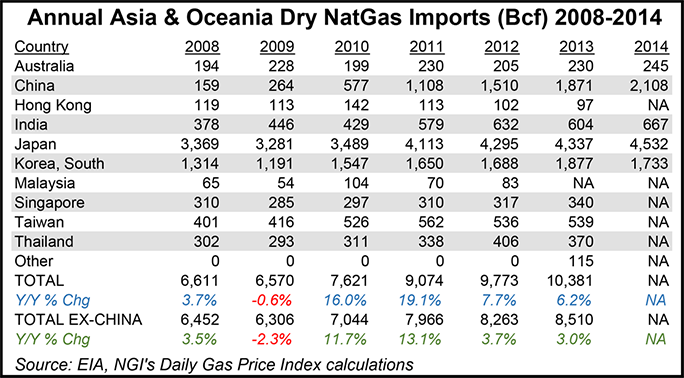NatGas Not All That Glitters in Asia, IEA Chief Says
Cheap coal and expanding renewable energy are pinching natural gas in some places around the world, while “inefficient” markets for liquefied natural gas have “lagged,” International Energy Agency (IEA) Executive Director Fatih Birol said Wednesday in Tokyo.

“For many, this means the ‘golden age’ of gas remains more of a dream than reality,” he said at the LNG Producer-Consumer Conference 2015. More than four years ago, an IEA report suggested that the world was entering a “golden age” for gas due to growing supplies from shale plays, environmental worries over coal-fired power plant emissions and the fizzling of the nuclear renaissance (see Daily GPI, June 7, 2011).
But the prediction hasn’t taken hold in Asian markets.
Asian consumers, as it turns out, will not take “any amount of LNG at any price,” Birol said. Gas has been losing market share to coal in India and in Association of Southeast Asian Nations countries, he said, adding that gas-fueled power generation is half what it was in India three years ago. “That is in absolute terms; the share of gas in total power generation has declined by even more. Meanwhile, coal-fired generation in India has increased by 25% as several new plants came online.” In Malaysia, a major gas producer, they’re burning coal and exporting gas because it is “more economical.”
Today in East Asia, one kilowatt-hour of power generated from coal is half the cost of the same kilowatt-hour generated from gas, according to Birol.
Gas from Russia is no longer the biggest obstacle to gas from elsewhere, he said. Today, natural gas/LNG faces increased competition from domestic coal and potentially solar power in India, for instance. Currently low natural gas prices provide “only a temporary window of opportunity” for gas to compete.
“…[T]here is no doubt that a golden age of gas remains possible — very possible. In fact, for some regions, like North America, it is already a reality. But in this part of the world, we have to move faster and with more determination to improve regulations, and to develop infrastructure and markets.”
© 2024 Natural Gas Intelligence. All rights reserved.
ISSN © 1532-1231 | ISSN © 2577-9877 |
